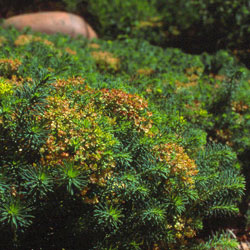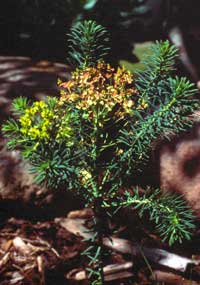Cypress Spurge
Euphorbia cyparissias
Keys to Identification
- Cypress spurge is a perennial that reproduces by seed and by spreading roots. The plant has many branched stems that are covered with numerous narrow leaves. The inconspicuous yellowish-green flowers are found in groups at the end of the main stem.
- The plant contains a milky sap that is irritating and may cause dermatitis.Although sheep may eat it, other animals will not.
This information courtesy of the Colorado Natural Areas Program
Family
Spurge (Euphorbiaceae)
Other Names
Graveyard spurge
USDA Code
EUCY2
Legal Status
Colorado Noxious Weed List A (new in Colorado – call your county weed supervisor!)
Identification
Lifecycle
Perennial
Growth form
Forb
Flower
The tiny, lime green to white flowers are clustered in small, cup-like structures. May-Sept.
Seeds/Fruit
The three-capsuled fruits of cypress spurge explode at maturity, ejecting the seeds.
Leaves
Leaves are stalkless, alternate, narrow, linear to lance-shaped.
Stems
Mature plants are about 1-1.5 feet tall.
Roots
The root system consists of long indeterminate roots, which spread both horizontally and vertically, and short determinant roots, which spread in a strictly horizontally.
Seedling
No information available.
Other
The entire plant exudes a white, milky sap that can be irritating to the skin.
Similar Species
Exotics
Can be distinguished from leafy spurge (Euphorbia esula) by its slender stems with numerous, crowded, narrow leaves.
Natives
None known.
Impacts
Agricultural
Its milky latex is toxic, but it is rarely consumed in quantities sufficient to cause serious injury. Animals should not be pastured where spurges grow. It does not tolerate intensive cultivation and is not a problem in crops.
Ecological
Cypress spurge is weedy plant that invades disturbed areas. Cypress spurge can reproduce rapidly, and quickly invade an area. Its ability to spread vegetatively is a major factor contributing to its success.
Human
Humans should be careful to avoid contacting the latex with bare skin.
Habitat and Distribution
General requirements
Cypress spurge commonly occurs in dry to moderately moist meadows, pastures, forest edges, roadsides, rights-of-way, cemeteries, and gardens. Cypress spurge generally does not occur on intensively cultivated soils (Stahevitch et al. 1988).
Distribution
Not yet widespread in Colorado. An escaped ornamental in some areas.
Historical
Native to Europe.
Biology/Ecology
Life cycle
Plants overwinter as seed or root and crown tissue. Over-wintering buds develop on the indeterminate roots (Stahevitch et al. 1988). New shoots emerge, and seeds germinate, each spring soon after the snow cover melts. Flowering begins the first or second week of May. Seeds may mature as early as the third week in June. A second flowering often occurs in late summer or early fall.
Mode of reproduction
Cypress spurge reproduces by vegetative propagation or seed.
Seed production
Cypress spurge generally produces between 30-900 seeds per plant, which exhibit germination rates of 85% (Stahevitch et al. 1988).
References
Stahevitch, A.E., C.W. Crompton, and W.A. Wojtas. The biology of Canadian weeds. 85. Euphorbia cyparissias L. Canadian Journal of Plant Science 68:175-191.
Whitson, T.D.(ed.), L.C. Burrill, S.A. Dewey, D.W. Cudney, B.E. Nelson, R.D. Lee, R. Parker. 1996. Euphorbia spp. Weeds of the West. Western Society of Weed Science, in cooperation with the Western United States Land Grant Universities Cooperative Extension Services, Newark CA. pg. 312.


